Comprehensive Analysis of Information Systems: Models and Security
VerifiedAdded on 2023/04/20
|7
|1406
|364
Essay
AI Summary
This essay provides a detailed overview of information systems (IS), utilizing the five-component framework (hardware, software, data, procedure, and people) to dissect its fundamental elements. It explores Porter’s five forces model as a strategic tool for analyzing industry competition and profitability. Various types of information systems are examined, including collaboration information systems, database management systems, content management systems, knowledge management systems, customer relationship management systems, enterprise resource management systems, social media IS, decision support systems, and enterprise IS. Furthermore, the essay discusses technical (e.g., firewalls) and human safeguards to protect against IS security threats, alongside an explanation of the Software Development Life Cycle (SDLC) and Scrum methodologies. The conclusion emphasizes the role of MIS in providing analytical information for decision-making, data management, trend analysis, and strategic planning.
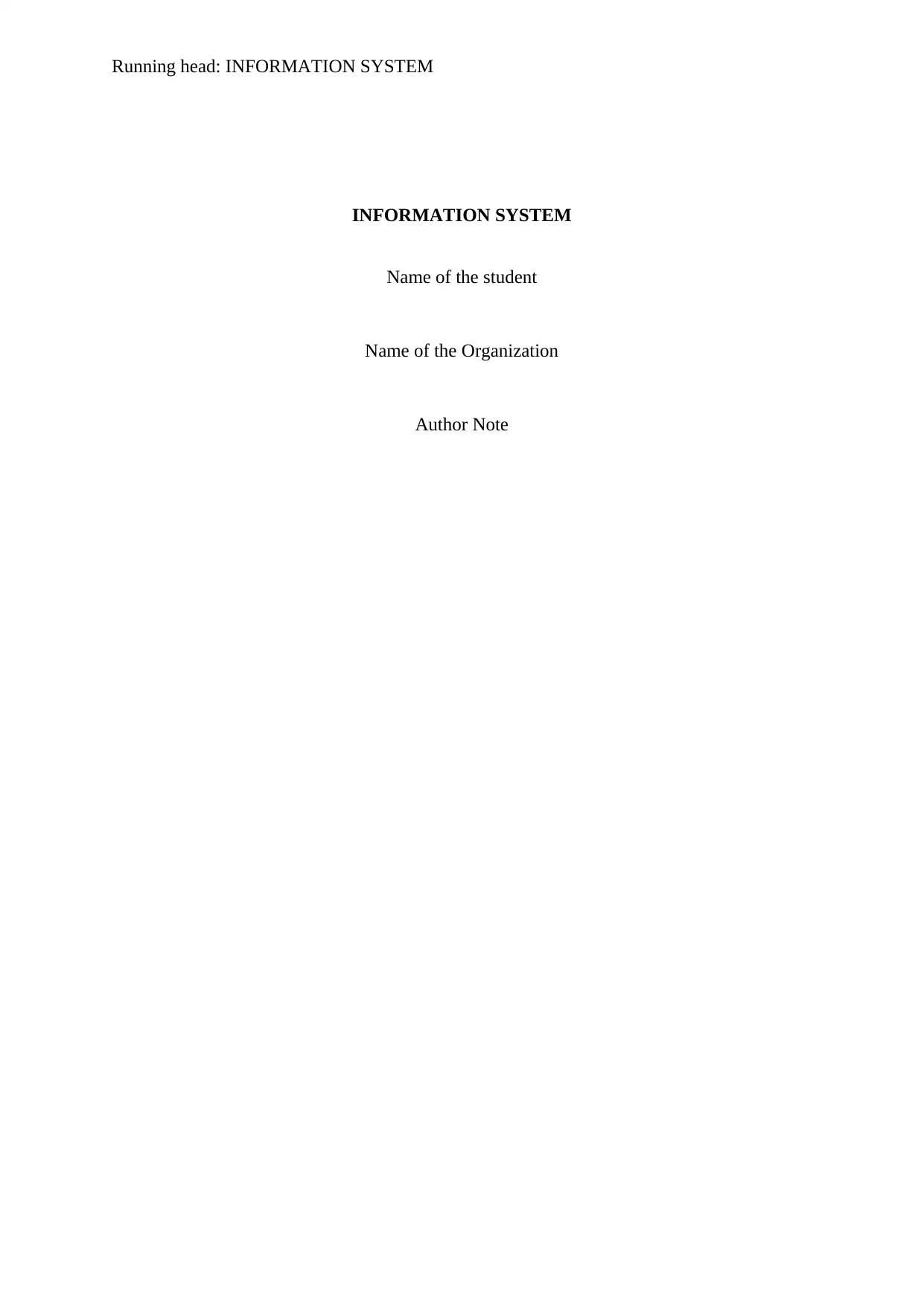
Running head: INFORMATION SYSTEM
INFORMATION SYSTEM
Name of the student
Name of the Organization
Author Note
INFORMATION SYSTEM
Name of the student
Name of the Organization
Author Note
Paraphrase This Document
Need a fresh take? Get an instant paraphrase of this document with our AI Paraphraser
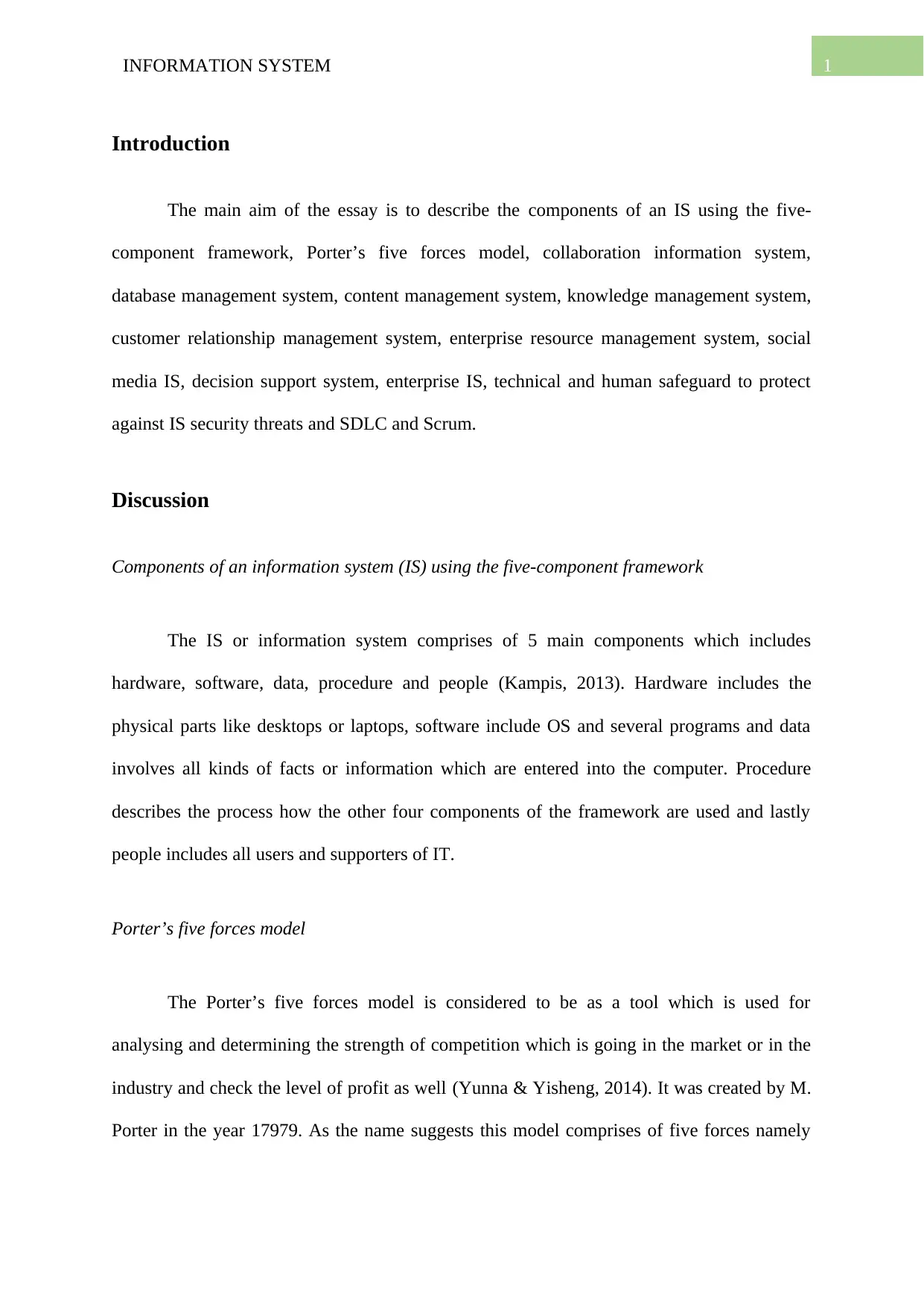
1INFORMATION SYSTEM
Introduction
The main aim of the essay is to describe the components of an IS using the five-
component framework, Porter’s five forces model, collaboration information system,
database management system, content management system, knowledge management system,
customer relationship management system, enterprise resource management system, social
media IS, decision support system, enterprise IS, technical and human safeguard to protect
against IS security threats and SDLC and Scrum.
Discussion
Components of an information system (IS) using the five-component framework
The IS or information system comprises of 5 main components which includes
hardware, software, data, procedure and people (Kampis, 2013). Hardware includes the
physical parts like desktops or laptops, software include OS and several programs and data
involves all kinds of facts or information which are entered into the computer. Procedure
describes the process how the other four components of the framework are used and lastly
people includes all users and supporters of IT.
Porter’s five forces model
The Porter’s five forces model is considered to be as a tool which is used for
analysing and determining the strength of competition which is going in the market or in the
industry and check the level of profit as well (Yunna & Yisheng, 2014). It was created by M.
Porter in the year 17979. As the name suggests this model comprises of five forces namely
Introduction
The main aim of the essay is to describe the components of an IS using the five-
component framework, Porter’s five forces model, collaboration information system,
database management system, content management system, knowledge management system,
customer relationship management system, enterprise resource management system, social
media IS, decision support system, enterprise IS, technical and human safeguard to protect
against IS security threats and SDLC and Scrum.
Discussion
Components of an information system (IS) using the five-component framework
The IS or information system comprises of 5 main components which includes
hardware, software, data, procedure and people (Kampis, 2013). Hardware includes the
physical parts like desktops or laptops, software include OS and several programs and data
involves all kinds of facts or information which are entered into the computer. Procedure
describes the process how the other four components of the framework are used and lastly
people includes all users and supporters of IT.
Porter’s five forces model
The Porter’s five forces model is considered to be as a tool which is used for
analysing and determining the strength of competition which is going in the market or in the
industry and check the level of profit as well (Yunna & Yisheng, 2014). It was created by M.
Porter in the year 17979. As the name suggests this model comprises of five forces namely
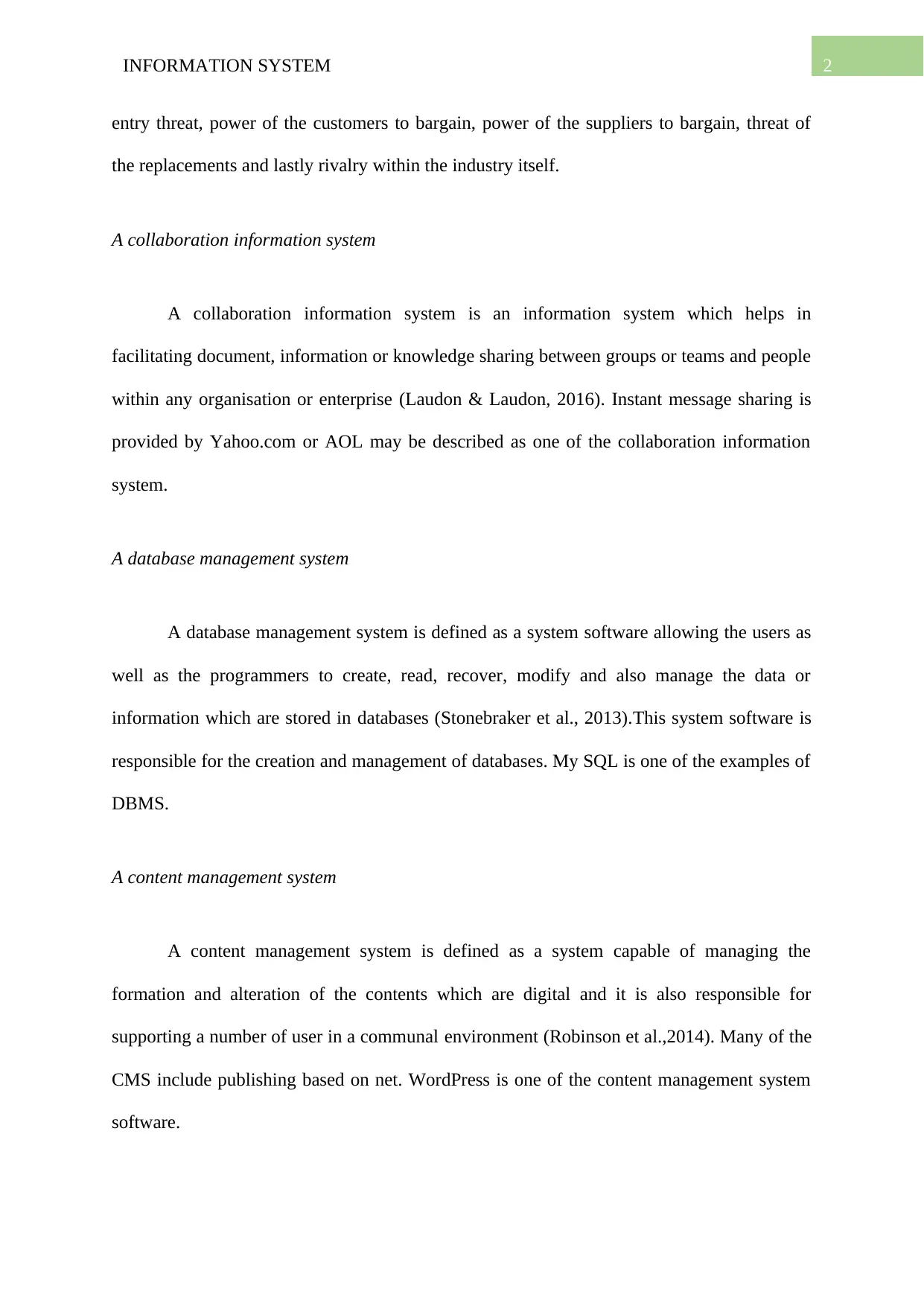
2INFORMATION SYSTEM
entry threat, power of the customers to bargain, power of the suppliers to bargain, threat of
the replacements and lastly rivalry within the industry itself.
A collaboration information system
A collaboration information system is an information system which helps in
facilitating document, information or knowledge sharing between groups or teams and people
within any organisation or enterprise (Laudon & Laudon, 2016). Instant message sharing is
provided by Yahoo.com or AOL may be described as one of the collaboration information
system.
A database management system
A database management system is defined as a system software allowing the users as
well as the programmers to create, read, recover, modify and also manage the data or
information which are stored in databases (Stonebraker et al., 2013).This system software is
responsible for the creation and management of databases. My SQL is one of the examples of
DBMS.
A content management system
A content management system is defined as a system capable of managing the
formation and alteration of the contents which are digital and it is also responsible for
supporting a number of user in a communal environment (Robinson et al.,2014). Many of the
CMS include publishing based on net. WordPress is one of the content management system
software.
entry threat, power of the customers to bargain, power of the suppliers to bargain, threat of
the replacements and lastly rivalry within the industry itself.
A collaboration information system
A collaboration information system is an information system which helps in
facilitating document, information or knowledge sharing between groups or teams and people
within any organisation or enterprise (Laudon & Laudon, 2016). Instant message sharing is
provided by Yahoo.com or AOL may be described as one of the collaboration information
system.
A database management system
A database management system is defined as a system software allowing the users as
well as the programmers to create, read, recover, modify and also manage the data or
information which are stored in databases (Stonebraker et al., 2013).This system software is
responsible for the creation and management of databases. My SQL is one of the examples of
DBMS.
A content management system
A content management system is defined as a system capable of managing the
formation and alteration of the contents which are digital and it is also responsible for
supporting a number of user in a communal environment (Robinson et al.,2014). Many of the
CMS include publishing based on net. WordPress is one of the content management system
software.
⊘ This is a preview!⊘
Do you want full access?
Subscribe today to unlock all pages.

Trusted by 1+ million students worldwide
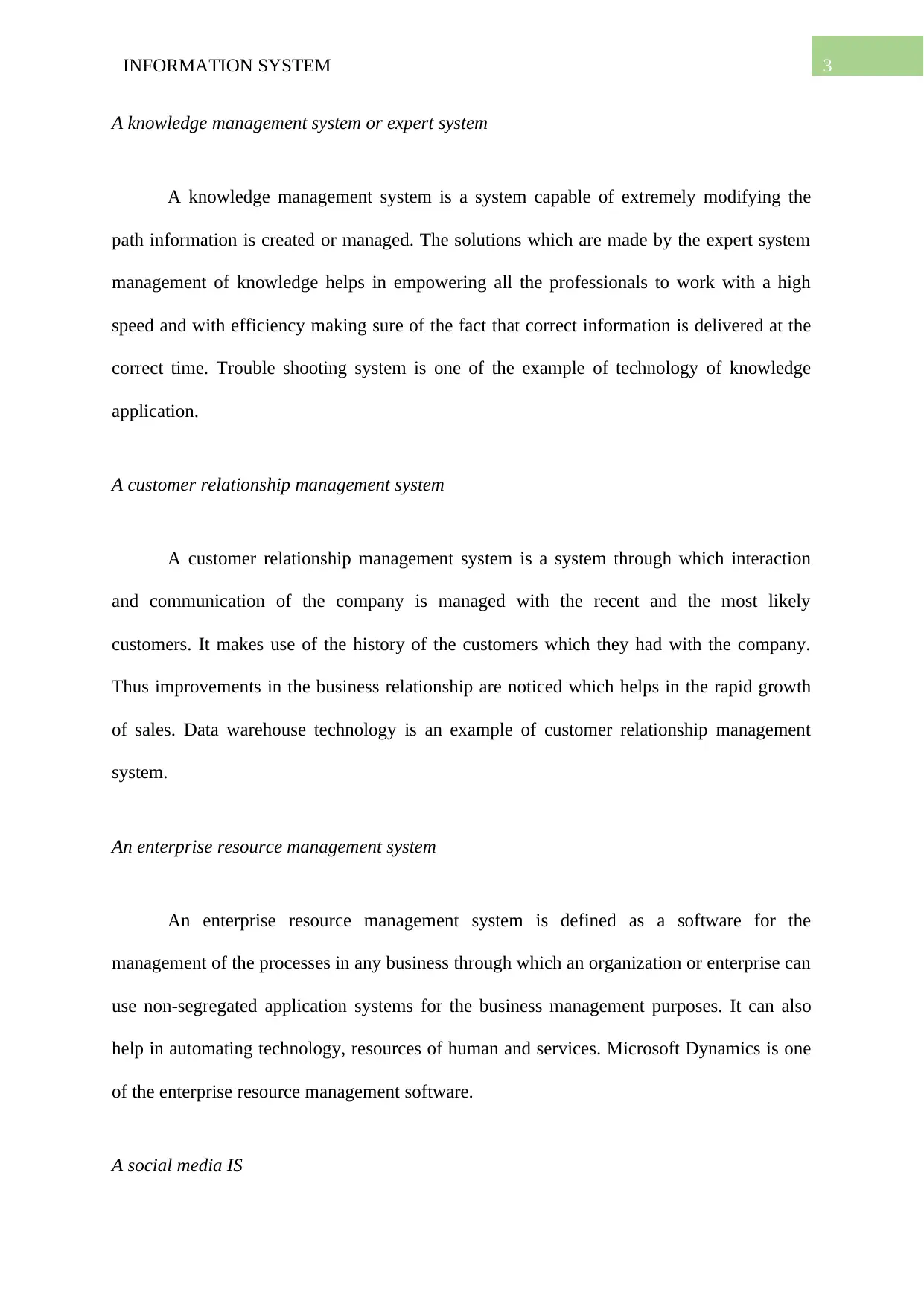
3INFORMATION SYSTEM
A knowledge management system or expert system
A knowledge management system is a system capable of extremely modifying the
path information is created or managed. The solutions which are made by the expert system
management of knowledge helps in empowering all the professionals to work with a high
speed and with efficiency making sure of the fact that correct information is delivered at the
correct time. Trouble shooting system is one of the example of technology of knowledge
application.
A customer relationship management system
A customer relationship management system is a system through which interaction
and communication of the company is managed with the recent and the most likely
customers. It makes use of the history of the customers which they had with the company.
Thus improvements in the business relationship are noticed which helps in the rapid growth
of sales. Data warehouse technology is an example of customer relationship management
system.
An enterprise resource management system
An enterprise resource management system is defined as a software for the
management of the processes in any business through which an organization or enterprise can
use non-segregated application systems for the business management purposes. It can also
help in automating technology, resources of human and services. Microsoft Dynamics is one
of the enterprise resource management software.
A social media IS
A knowledge management system or expert system
A knowledge management system is a system capable of extremely modifying the
path information is created or managed. The solutions which are made by the expert system
management of knowledge helps in empowering all the professionals to work with a high
speed and with efficiency making sure of the fact that correct information is delivered at the
correct time. Trouble shooting system is one of the example of technology of knowledge
application.
A customer relationship management system
A customer relationship management system is a system through which interaction
and communication of the company is managed with the recent and the most likely
customers. It makes use of the history of the customers which they had with the company.
Thus improvements in the business relationship are noticed which helps in the rapid growth
of sales. Data warehouse technology is an example of customer relationship management
system.
An enterprise resource management system
An enterprise resource management system is defined as a software for the
management of the processes in any business through which an organization or enterprise can
use non-segregated application systems for the business management purposes. It can also
help in automating technology, resources of human and services. Microsoft Dynamics is one
of the enterprise resource management software.
A social media IS
Paraphrase This Document
Need a fresh take? Get an instant paraphrase of this document with our AI Paraphraser
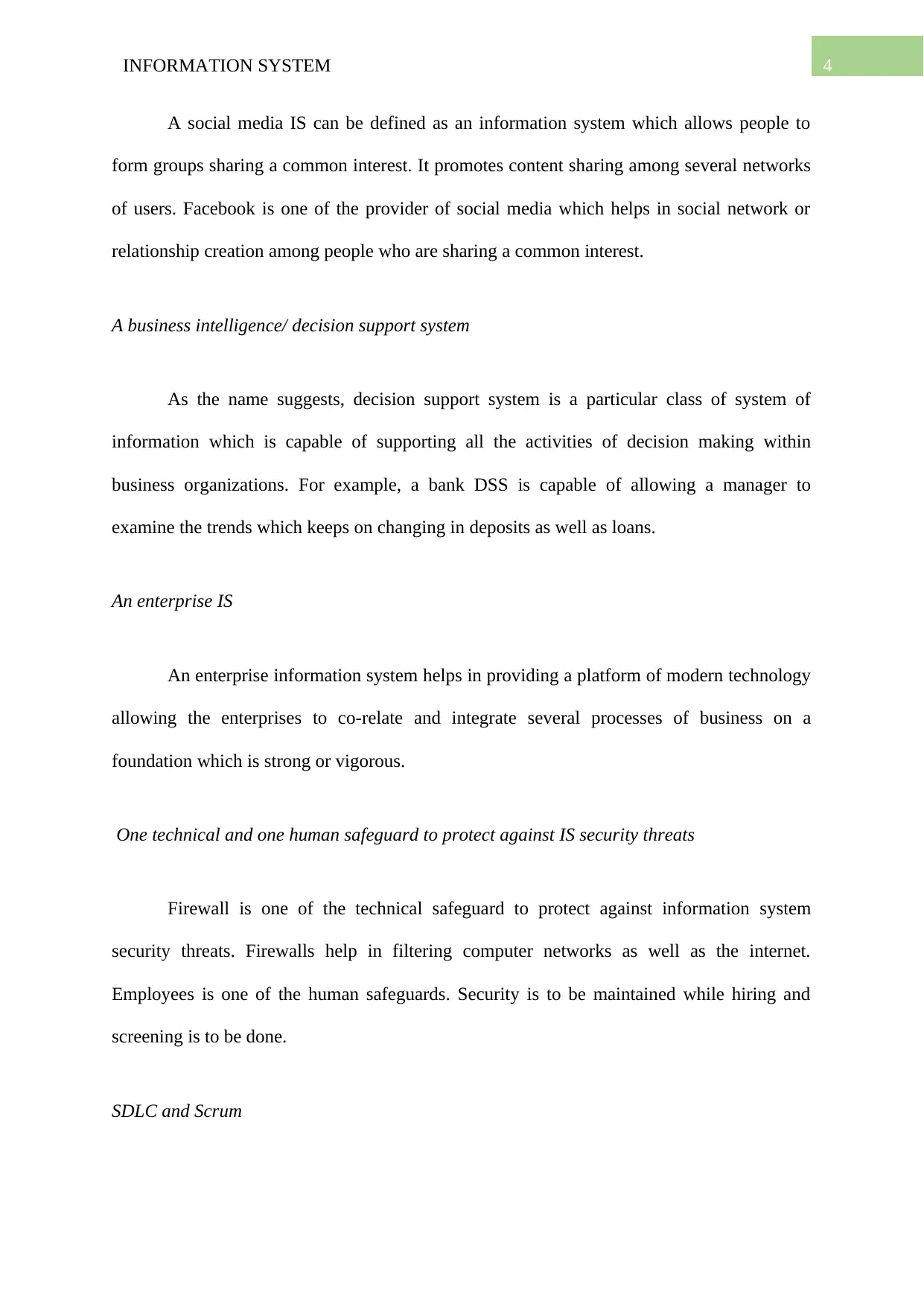
4INFORMATION SYSTEM
A social media IS can be defined as an information system which allows people to
form groups sharing a common interest. It promotes content sharing among several networks
of users. Facebook is one of the provider of social media which helps in social network or
relationship creation among people who are sharing a common interest.
A business intelligence/ decision support system
As the name suggests, decision support system is a particular class of system of
information which is capable of supporting all the activities of decision making within
business organizations. For example, a bank DSS is capable of allowing a manager to
examine the trends which keeps on changing in deposits as well as loans.
An enterprise IS
An enterprise information system helps in providing a platform of modern technology
allowing the enterprises to co-relate and integrate several processes of business on a
foundation which is strong or vigorous.
One technical and one human safeguard to protect against IS security threats
Firewall is one of the technical safeguard to protect against information system
security threats. Firewalls help in filtering computer networks as well as the internet.
Employees is one of the human safeguards. Security is to be maintained while hiring and
screening is to be done.
SDLC and Scrum
A social media IS can be defined as an information system which allows people to
form groups sharing a common interest. It promotes content sharing among several networks
of users. Facebook is one of the provider of social media which helps in social network or
relationship creation among people who are sharing a common interest.
A business intelligence/ decision support system
As the name suggests, decision support system is a particular class of system of
information which is capable of supporting all the activities of decision making within
business organizations. For example, a bank DSS is capable of allowing a manager to
examine the trends which keeps on changing in deposits as well as loans.
An enterprise IS
An enterprise information system helps in providing a platform of modern technology
allowing the enterprises to co-relate and integrate several processes of business on a
foundation which is strong or vigorous.
One technical and one human safeguard to protect against IS security threats
Firewall is one of the technical safeguard to protect against information system
security threats. Firewalls help in filtering computer networks as well as the internet.
Employees is one of the human safeguards. Security is to be maintained while hiring and
screening is to be done.
SDLC and Scrum
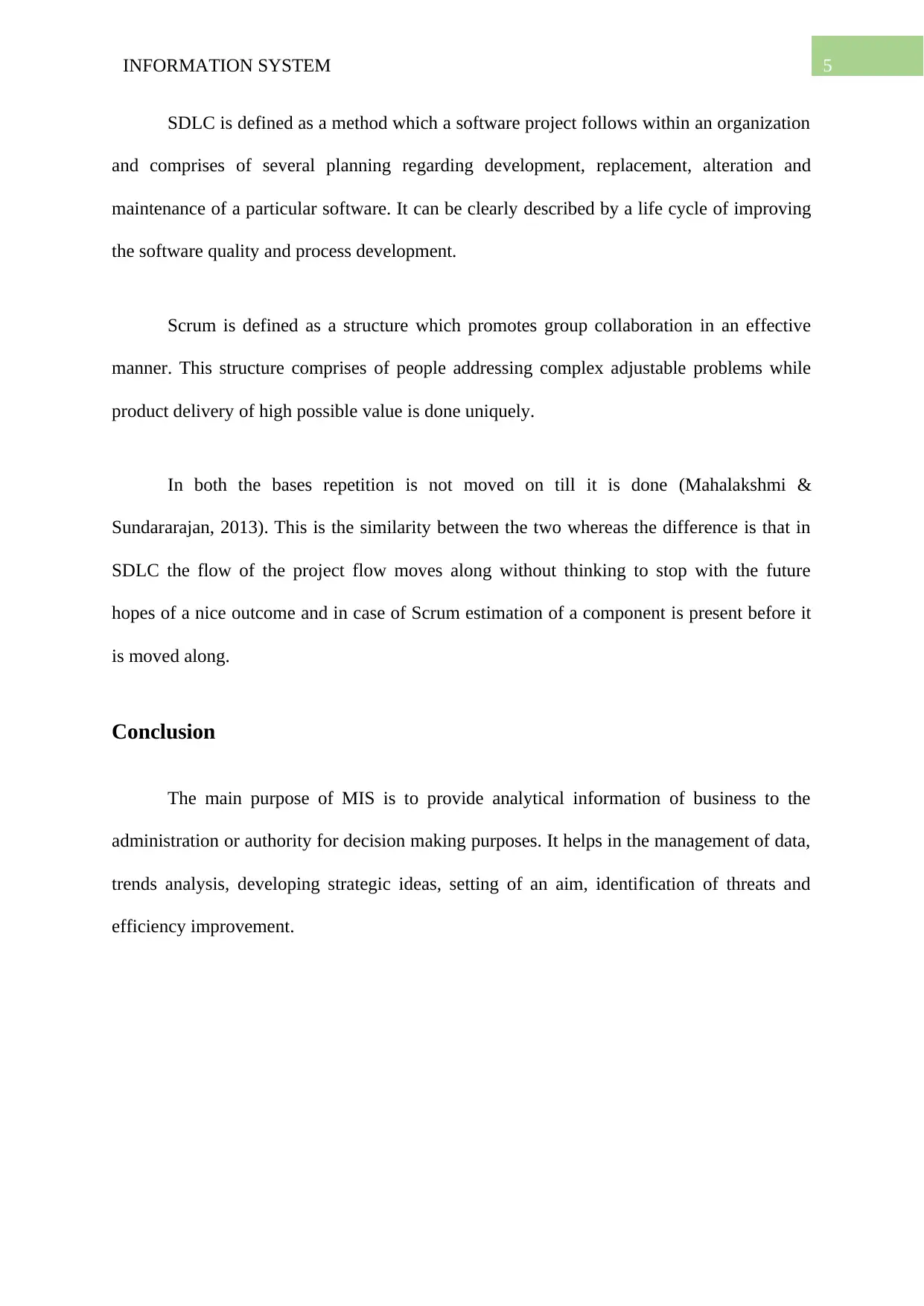
5INFORMATION SYSTEM
SDLC is defined as a method which a software project follows within an organization
and comprises of several planning regarding development, replacement, alteration and
maintenance of a particular software. It can be clearly described by a life cycle of improving
the software quality and process development.
Scrum is defined as a structure which promotes group collaboration in an effective
manner. This structure comprises of people addressing complex adjustable problems while
product delivery of high possible value is done uniquely.
In both the bases repetition is not moved on till it is done (Mahalakshmi &
Sundararajan, 2013). This is the similarity between the two whereas the difference is that in
SDLC the flow of the project flow moves along without thinking to stop with the future
hopes of a nice outcome and in case of Scrum estimation of a component is present before it
is moved along.
Conclusion
The main purpose of MIS is to provide analytical information of business to the
administration or authority for decision making purposes. It helps in the management of data,
trends analysis, developing strategic ideas, setting of an aim, identification of threats and
efficiency improvement.
SDLC is defined as a method which a software project follows within an organization
and comprises of several planning regarding development, replacement, alteration and
maintenance of a particular software. It can be clearly described by a life cycle of improving
the software quality and process development.
Scrum is defined as a structure which promotes group collaboration in an effective
manner. This structure comprises of people addressing complex adjustable problems while
product delivery of high possible value is done uniquely.
In both the bases repetition is not moved on till it is done (Mahalakshmi &
Sundararajan, 2013). This is the similarity between the two whereas the difference is that in
SDLC the flow of the project flow moves along without thinking to stop with the future
hopes of a nice outcome and in case of Scrum estimation of a component is present before it
is moved along.
Conclusion
The main purpose of MIS is to provide analytical information of business to the
administration or authority for decision making purposes. It helps in the management of data,
trends analysis, developing strategic ideas, setting of an aim, identification of threats and
efficiency improvement.
⊘ This is a preview!⊘
Do you want full access?
Subscribe today to unlock all pages.

Trusted by 1+ million students worldwide
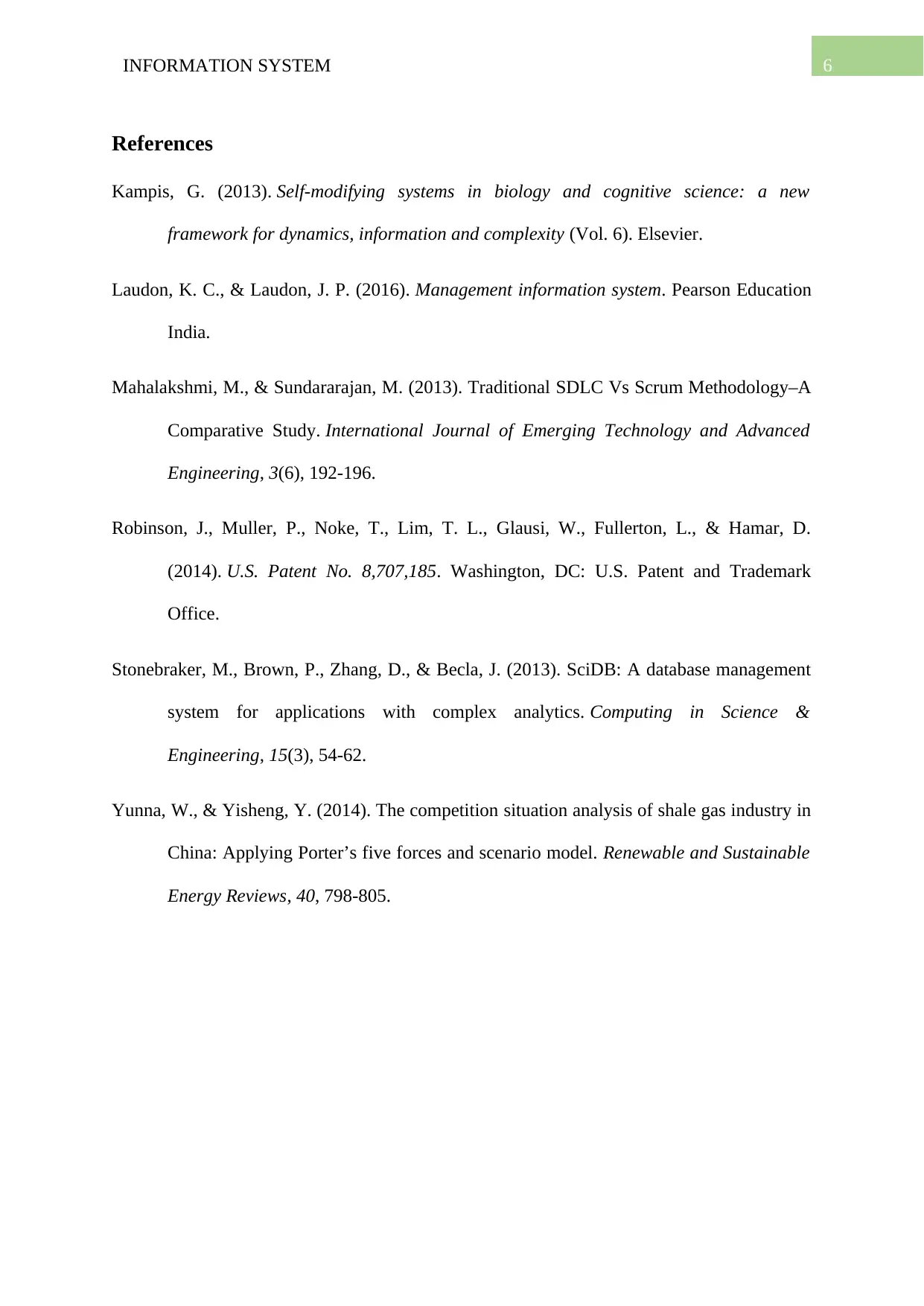
6INFORMATION SYSTEM
References
Kampis, G. (2013). Self-modifying systems in biology and cognitive science: a new
framework for dynamics, information and complexity (Vol. 6). Elsevier.
Laudon, K. C., & Laudon, J. P. (2016). Management information system. Pearson Education
India.
Mahalakshmi, M., & Sundararajan, M. (2013). Traditional SDLC Vs Scrum Methodology–A
Comparative Study. International Journal of Emerging Technology and Advanced
Engineering, 3(6), 192-196.
Robinson, J., Muller, P., Noke, T., Lim, T. L., Glausi, W., Fullerton, L., & Hamar, D.
(2014). U.S. Patent No. 8,707,185. Washington, DC: U.S. Patent and Trademark
Office.
Stonebraker, M., Brown, P., Zhang, D., & Becla, J. (2013). SciDB: A database management
system for applications with complex analytics. Computing in Science &
Engineering, 15(3), 54-62.
Yunna, W., & Yisheng, Y. (2014). The competition situation analysis of shale gas industry in
China: Applying Porter’s five forces and scenario model. Renewable and Sustainable
Energy Reviews, 40, 798-805.
References
Kampis, G. (2013). Self-modifying systems in biology and cognitive science: a new
framework for dynamics, information and complexity (Vol. 6). Elsevier.
Laudon, K. C., & Laudon, J. P. (2016). Management information system. Pearson Education
India.
Mahalakshmi, M., & Sundararajan, M. (2013). Traditional SDLC Vs Scrum Methodology–A
Comparative Study. International Journal of Emerging Technology and Advanced
Engineering, 3(6), 192-196.
Robinson, J., Muller, P., Noke, T., Lim, T. L., Glausi, W., Fullerton, L., & Hamar, D.
(2014). U.S. Patent No. 8,707,185. Washington, DC: U.S. Patent and Trademark
Office.
Stonebraker, M., Brown, P., Zhang, D., & Becla, J. (2013). SciDB: A database management
system for applications with complex analytics. Computing in Science &
Engineering, 15(3), 54-62.
Yunna, W., & Yisheng, Y. (2014). The competition situation analysis of shale gas industry in
China: Applying Porter’s five forces and scenario model. Renewable and Sustainable
Energy Reviews, 40, 798-805.
1 out of 7
Related Documents
Your All-in-One AI-Powered Toolkit for Academic Success.
+13062052269
info@desklib.com
Available 24*7 on WhatsApp / Email
![[object Object]](/_next/static/media/star-bottom.7253800d.svg)
Unlock your academic potential
Copyright © 2020–2025 A2Z Services. All Rights Reserved. Developed and managed by ZUCOL.




